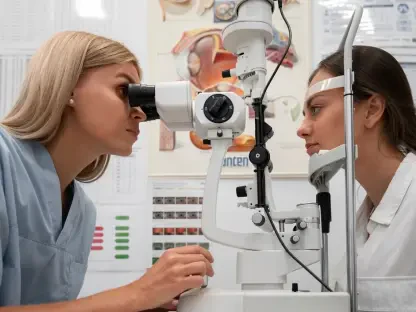Introduction to a Shifting Landscape in Lung Cancer Treatment
In the realm of oncology, non-small cell lung cancer (NSCLC) remains a formidable challenge, accounting for a significant portion of cancer diagnoses worldwide, and within this broad category, a small but critical subset—HER2-mutant NSCLC, affecting 2% to 4% of cases—presents unique difficulties due to its association with poor prognosis and limited treatment options. This rare mutation often impacts younger, non-smoking women, a demographic that has historically faced a scarcity of targeted therapies tailored to their specific needs. The urgency to address this gap has spurred remarkable innovation, setting the stage for a transformative era in precision medicine for this underserved group.
The emergence of targeted therapies marks a pivotal shift, as pharmaceutical giants race to deliver solutions for HER2-mutant NSCLC patients. With recent regulatory milestones, the treatment landscape is evolving rapidly, offering renewed hope where options were once sparse. This report delves into the competitive dynamics and clinical advancements reshaping care for this niche population, spotlighting two groundbreaking drugs now at the forefront of this battle.
Breakthrough Developments in HER2-Mutant NSCLC Therapies
Approval Milestones and Clinical Insights
The U.S. Food and Drug Administration (FDA) has recently granted accelerated approval to Bayer’s Hyrnuo (sevabertinib), an oral HER2 tyrosine kinase inhibitor designated as a second-line treatment for advanced HER2-mutant NSCLC. This approval, grounded in data from the SOHO-01 trial, revealed an impressive 71% objective response rate (ORR) alongside a median duration of response (DOR) of 9.2 months. Priced at $24,000 per month for a twice-daily regimen, Hyrnuo enters the market as a formidable option for patients who have progressed beyond initial therapies.
In a parallel stride, Boehringer Ingelheim’s Hernexeos (zongertinib) secured FDA approval in August for the same indication, based on findings from the Beamion LUNG-1 study. This drug also demonstrated a 71% ORR but with a longer DOR of 14.1 months, and it comes at a slightly lower cost of $21,667 for a 60-count bottle intended for once-daily dosing. While the efficacy metrics appear comparable at first glance, variations in trial designs and patient cohorts necessitate caution in drawing direct comparisons between the two therapies.
These approvals underscore a significant leap forward in addressing a critical unmet need within oncology. Both drugs offer substantial benefits, yet differences in pricing and dosing frequency could influence clinical decision-making. As the market absorbs these new entrants, attention turns to how these factors will shape adoption among healthcare providers and patients alike.
Precision Diagnostics as a Cornerstone of Treatment
Alongside Hyrnuo’s approval, the FDA also endorsed a companion diagnostic developed by Life Technologies, designed to detect HER2 tyrosine kinase domain-activating mutations. This tool ensures accurate identification of eligible patients, a crucial step in tailoring therapy to those most likely to benefit. The integration of such diagnostics into clinical practice reflects a broader commitment to precision medicine in NSCLC management.
The role of companion diagnostics extends beyond mere identification; it represents a fundamental shift toward personalized care. By aligning treatments with specific genetic profiles, these tools help maximize therapeutic outcomes while minimizing unnecessary interventions. This development is poised to streamline patient selection processes, enhancing the overall efficacy of targeted therapies in this space.
Market Challenges for Rare Subtype Therapies
The rarity of HER2-mutant NSCLC, while highlighting the importance of specialized treatments, also poses significant hurdles for drug developers. With a limited patient population, the high costs associated with research and development can strain financial models, often resulting in elevated drug prices. This economic reality creates a delicate balance between innovation and accessibility for stakeholders across the healthcare spectrum.
Beyond financial considerations, practical challenges such as dosing regimens and duration of response play a critical role in shaping preferences among physicians and patients. For instance, the twice-daily dosing of Hyrnuo contrasts with the once-daily schedule of Hernexeos, potentially impacting patient adherence. Additionally, variations in response duration may sway treatment choices, adding layers of complexity to clinical decision-making.
Reimbursement and pricing concerns further complicate the landscape, as payers grapple with the high costs of both Hyrnuo and Hernexeos. Navigating insurance coverage and ensuring equitable access remain pressing issues, particularly for a niche therapy targeting a small subset of NSCLC patients. Addressing these barriers will be essential to maximizing the impact of these innovative drugs in real-world settings.
Regulatory Framework and Compliance Considerations
The FDA’s accelerated approval pathway has proven instrumental in expediting the availability of novel cancer therapies like Hyrnuo and Hernexeos. By prioritizing speed without compromising safety, this mechanism allows patients to access cutting-edge treatments sooner, often based on promising early-phase trial data. However, it also places emphasis on post-approval studies to confirm long-term efficacy and safety profiles.
Companion diagnostics, as seen with Hyrnuo, are increasingly integral to regulatory approvals, ensuring that treatments are matched to the right patients. Their seamless incorporation into clinical workflows highlights a growing synergy between diagnostics and therapeutics in oncology. This trend not only supports regulatory compliance but also enhances the precision of treatment delivery.
Ongoing monitoring and post-marketing surveillance remain vital components of maintaining compliance in this field. These efforts safeguard patient well-being by identifying any unforeseen adverse effects or areas for improvement. As regulatory expectations evolve, pharmaceutical companies must stay agile, adapting to new guidelines to uphold the highest standards of care.
Future Horizons in HER2-Targeted Innovations
Both Bayer and Boehringer Ingelheim share an ambitious vision to expand their drugs’ indications beyond second-line treatment for HER2-mutant NSCLC. Early data presented at the ESMO congress indicate promising results for first-line applications, with Hernexeos achieving a 77% ORR and Hyrnuo matching its second-line performance at 71% ORR in untreated populations. These findings suggest a potential paradigm shift in early intervention strategies.
To build on this momentum, phase 3 trials are underway, including Beamion LUNG-2 for Hernexeos and SOHO-2 for Hyrnuo, focusing on frontline therapy. Boehringer is also exploring adjuvant applications through the Beamion LUNG-3 trial for early-stage NSCLC, while Bayer’s panSOHO study targets HER2-positive solid tumors outside NSCLC. These initiatives reflect a broader scope of research aimed at addressing diverse patient needs.
Bayer estimates that up to 84,000 individuals are diagnosed annually worldwide with HER2-positive NSCLC, pointing to substantial market potential. This figure underscores the importance of continued investment in targeted therapies. As personalized cancer care advances, driven by competition and innovation, the industry is witnessing a transformative wave that prioritizes patient-specific solutions over one-size-fits-all approaches.
Closing Reflections on a Competitive Era
Looking back, the FDA’s approval of Bayer’s Hyrnuo marked a defining moment, intensifying competition with Boehringer Ingelheim’s Hernexeos in the HER2-mutant NSCLC arena. The comparable efficacy of both therapies, coupled with distinct differences in dosing and pricing, shaped a dynamic market landscape that challenged stakeholders to rethink treatment paradigms. This rivalry underscored the power of innovation in addressing long-standing gaps in oncology care.
Moving forward, actionable steps include prioritizing access through strategic reimbursement models to ensure these high-cost therapies reach those in need. Additionally, accelerating research into first-line and adjuvant applications offers a pathway to redefine standards of care for broader patient groups. Collaboration between industry, regulators, and healthcare providers emerges as a key consideration to sustain this momentum.
The journey ahead also calls for a deeper focus on integrating precision diagnostics into routine practice, enhancing patient outcomes through tailored interventions. As the field continues to evolve, the commitment to balancing innovation with affordability stands out as a critical factor in shaping the next chapter of HER2-targeted therapies. This era of competition and progress lays a robust foundation for future breakthroughs in personalized medicine.









